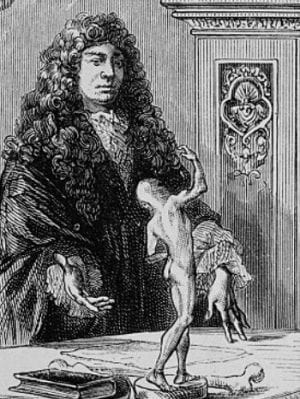Joseph Guichard Duverney
Joseph Guichard Duverney (1648-1730) was a French Anatomist and Surgeon.
Considered to be the first French otologist of the 17th century and one of the first European otologists. An anatomist of some renown he dissected an elephant before king Louis XIV in 1681.
Duverney published one of the first complete works on otology – Traité de l’organe de l’ouïe in 1683, discussing the anatomy, physiology and diseases of the ear. Duverney reports on a brain tumour, believed to be the earliest description of cholesteatoma. Translated into many languages and a key reference book for the 17th and 18th century. Duverney is rightly considered to be the first French otologist of the 17th century and one of the first European otologists.
Duverney’s Maladies des os (“Diseases of the bones”) was published posthumously in 1751 and includes a description of the eponymous ‘Duverney fracture‘. The observations are carefully made and supported by thorough anatomical studies. The section on bone diseases contains excellent descriptions of the gross pathologic features of rickets and one of the earliest descriptions of osteoporosis.
Biography
- Born on August 5, 1648
- 1667 – Medical doctorate in Avignon, France
- 1676 – member of the Académie des sciences
- 1682 – Professor of anatomy at Jardin du Roi
- 1683 – published- Traité de l’organe de l’ouie – the earliest and most comprehensive work in otology
- Died on September 10, 1730
Medical Eponyms
Duverney fracture
Isolated fracture of the iliac wing due to direct lateral compression. Most commonly occurring in the setting of a direct blow to the ilium. Stable pelvic injury but may require operative intervention in cases of severe comminution.
1751 – Duverney’s description of the isolated fracture of the wing of the ilium is found in his Traité des maladies des os published from his notes, 21 years after his death. The two volume work contains sections on the diagnosis and treatment of fractures; dislocations; and diseases of bone.
On the fracture of the wing of the ilium:
Un Ouvrier portoit un bandage d’acier. Il tomba sur le côté de fort haut. Le bandage fut cassé. Il ne se trouva presque point incommodé dans le moment, si ce n’est qu’il ne pût marcher. Il fut porté à l’Hôtel dieu, où l’on, ne connut aucune fracture dans l’etendue de son corps.
Il fut enveloppé dans les peaux de moutons, dont il ne reçut que peu de soulagement ; les urines se supprimerent; il se déclara une grande constitution , avec une ecchymose qui occupoit tout le côté sur lequel il eioit tombé; la jambe & la cuisse etoient sans mouvement.
Le gonflement & la tension de ces parties firent penser que la cuisse etoit luxée; accident dont l’on ne pût s’assurer, non plus que de la fracture de l’os des iles. Le malade fut soigneusement traité ; mais ces soins par la suite devînrent inutiles ; il mourut le quatorzième de sa chûte. Je me trouvai à l’ouvertuœ du cadavre.
Le bassin etoit entièrement plein de pus; l’iliaque & le psoas, tout déchirés, & l’os des iles fracturé en travers , sans que les pièces eussent changé de place.
A worker was carrying a steel rim. He fell onto his side from a great height. The rim broke. He did not feel hardly uncomfortable in the moment, were it not that he could not walk. He was taken to the Hôtel-dieu, where we did not recognize a fracture in the whole length of his body.
He was wrapped in lambskins, from which he gained little relief. His urination ceased; a great consitution presented, with an ecchymosis occupying the whole side onto which he fell; the leg and the thigh were without movement.
The swelling and the tension of these parts suggested that the thigh was luxated; an accident of which we could not be certain, no more than of a fracture of the iliac bone. The patient was treated carefully; but subsequently these treatments became useless; he died on the fourteenth following his fall. I was present at the opening of the cadaver.
The pelvis was entirely filled with pus; the iliacus and the psoas completely torn, and the Iliac bone fractured in transverse, without the fragments having moved.
Key medical contributions
Otology
In 1683, Duverney published Traité de l’organe de l’ouie, arguably the earliest and most comprehensive work in otology. In the book he discusses the anatomy, physiology and diseases associated with the ear.
In collaboration with French physicist Edme Mariotte (1620-1682) he developed a conceptual overview of the physiological relationships within the cochlea, very similar to those later published by German physiologist Hermann von Helmholtz (1821–1894).
He identified a temporal bone tumour, which is believed to be the earliest description of cholesteatoma.
Monsieur Bonnet, celebre Medecin de Geneve… qui raporte que Mr. Drelincourt trouva dans le Cerveau d’un homme qui etoit mort d’Apoplexie un Steatome entre le cerveau & le cervelet, lequel causa d’abord un aveuglement, ensuite une surdité, & finalement une entiere privation de toutes les fonctions animales.
Mr. Bonnet, famous doctor from Geneva… who reports that Mr. Drelincourt found, in the brain of a man who died of apoplexy, a steatoma between the cerebrum and the cerebellum, which caused first blindness, then deafness, and finally a complete privation of all the animal functions.
Duverney realized the importance of the Eustachian tube and its role in adjusting air pressure in the tympanic cavity but mistakenly felt that it was normally open, acting as a vent to the air, when the eardrum moves in and out. While the physiology was in error, the concept that air pressure was adjusted by the Eustachian tube was an innovation at the time.
Osteoporosis
Du Verney also gives an early description of osteoporosis, and a first hypothesis as to its aetiology:
Expliquons maintenant comment les os, qui doivent être très durs dans les adultes, se cassent quelquefois comme du verre.
En effet, on a vû plusieurs fois que certains os se cassent aisément, & sans qu’on leur fasse aucune violence… Les uns voulant prendre le pot de chambre, les autres en levant les bras pour prendre une chemise, se sont fait des fractures…
Cette fragilitié peut être produite dans les os par leur extrême secheresse, qui depend de trois causes, du manque de nourriture, du deffaut de moëlle, & de l’action des sels corrosifs.
Let us explain now how the bones, which should be quite firm in adults, can sometimes break like glass.
In fact, we have seen numerous times how the bones can break easily, and without suffering any violence… Some, whilst taking their chamberpot, others whilst lifting the arms to put on a shirt, have caused fractures…
This fragility can be produced in the bones by their extreme dryness, which depends on three causes, the lack of nutrition, the defect of the marrow, and the action of corrosive salts
Rickets
A fascinating chapter devoted to rickets, with detailed descriptions on the presentation of these cases. Note however that Du Verney does not claim to be the first to describe this!
Les Anglois appellent ces enfans riquets. Glisson, qui est le prémier qui ait ecrit de cette maladie, cherchant l’étymologie de ce mot, dit qu’un anglois lui donna sans y penser celui de rachitis, qui signifie en Grec maladie de l’epine. On appelle en France, enfans noués, ceux qui en sont attaqués, parce qu’ils n’ont pas la liberé de se mouvoir…
Les riquets ont la tête plus grosse à proportion que les autres enfans de leur âge… le tibia & le péroné sont courbés vers le côté extérieur de chaque jambe… ainsi les pieds se trouvent fort écartés de la ligne de direction; ce qui fait que ces enfans marchent comme les cannes, c’est à dire qu’ils boitent à droite & à gouche
The English name these children rickets. Glisson, who is the first to have written on this illness, searching for the etymology of the word, says that an englishman named it, without too much thought, rickets, which in greek signifies illness of the spine. In France, we call those affected knotted children, as they don’t have the liberty to move…
The rickets have a head proportionally larger than other children their age… the tibia and fibula are curved to the exterior on each side… such that the feet point well outwards from the direction they are facing; which means that these children walk like the lame; meaning they hobble from side to side
Bartholin gland
Duverney first described ‘vulvovaginal glands’ in cattle in 1676. His student Caspar Bartholin the Younger (1655 – 1738) formalised the finding in the human female (Bartholin gland) in 1677
About the middle of the seventeenth century Duverney discovered (at either side of the entrance of the vagina in the cow) a duct leading to a large lobulated gland which was covered by the skin and the constrictor vaginae muscle. Bartholinus, to whom Duverney mentioned the existence of these organs, discovered them in the human female, and compared them to the prostate in the male. Duverney confirmed the observation of Bartholinus, and after him Peyer, Harder, Morgagni, Santorini, and others, saw and described them.
Tiedemann 1843
Controversies
- Alternative spelling – Joseph-Guichard Du Verney
Major Publications
- Du Verney J. Traité de l’organe de l’ouïe: Contenant La Structure, Les Usages & Les Maladies De Toutes Les Parties De L’oreille [Treatise on the organ of hearing] 1683.
- Du Verney J. Tractatus de organo auditis continens structuram, usam, et morbos omnium auris partium. 1730
- Perrault C. Mémoires pour servir à l’histoire naturelle des animaux. 1733 [Descriptions of Duverney dissections]
- Duverney JG. Traité des maladies des os [Treatise on diseases of the bones] Posthumous publication, de Bure l’aîné. 1751 [Tome II]
- Du Verney J. De la fracture des os qui composent le Bassin, Observation II. In: Traité des maladies des os. Paris. 1751; I: 285–287 [Duverney fracture]
- Duverney JG. Oeuvres anatomiques. 1761 [Tome II]
References
Biography
- Fontenelle. Éloge de Du Verney. In: Éloges de Fontenelle. 1883
- Guerrini A. Duverney’s skeletons. Isis. 2003; 94(4): 577-603.
- Mostofi SB. Joseph Guichard Duverney, In: Who’s Who in Orthopedics. 2005: 92-93
- Guerrini A. Theatrical anatomy: Duverney in Paris, 1670-1720. Endeavour. 2009; 33(1): 7-11
- Benkhadra M et al. Joseph-Guichard Duverney (1648-1730). Médecin, anatomiste et chercheur aux xviie et xviiie siècles [Joseph-Guichard Duverney (1648-1730). Doctor, teacher and researcher in the 17th and 18th centuries]. Morphologie. 2010; 94(306): 63-67.
- Guerrini A. Perrault, Buffon and the natural history of animals. Notes Rec. R. Soc. 2012; 66: 393–409
- Bibliography. Joseph Guichard Duverney (1648-1730). World Cat Identities
Eponymous terms
- Tiedemann F. Von den Duverneyschen, Bartholinschen oder Cowperschen Drüsen des Weibes und der schiefen Gestaltung und Lage der Gebärmutter. 1840
- Professor Tiedemann on the Glands of Duverney, Bartholinus, or Cowper in the Human Female; and on Obliquity in the Form and Position of the Uterus. Br Foreign Med Rev. 1843; 16(31): 155-157.
- Peltier LF. Joseph Guichard Duverney (1648-1730). Champion of applied comparative anatomy. Clin Orthop Relat Res. 1984; 187: 308-11.
- Duverney JG. Duverney’s fracture. 1751. Clin Orthop Relat Res. 1996; (329): 4-5.
- Mudry A. Guichard Joseph Duverney, premier otologiste français au XVII e siècle [First French otologist in the 17th century] Ann Otolaryngol Chir Cervicofac. 2000; 117(4): 203-9.
- Somford MP, de Visser E, IJpma FF. The origins and current applications of classic eponymous terms for pelvic and acetabular fractures: A historic review. J Trauma Acute Care Surg. 2017; 82(4): 802-809
Resident medical officer in emergency medicine MB ChB (Uni. Dundee) MRCS Ed. Avid traveller, yoga teacher, polylinguist with a passion for discovering cultures.



